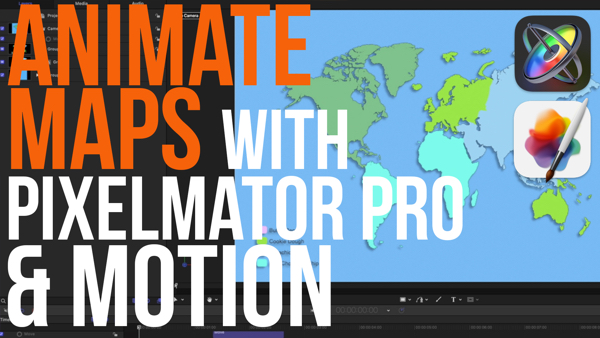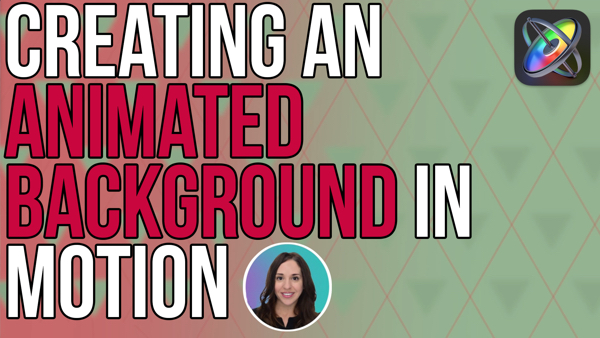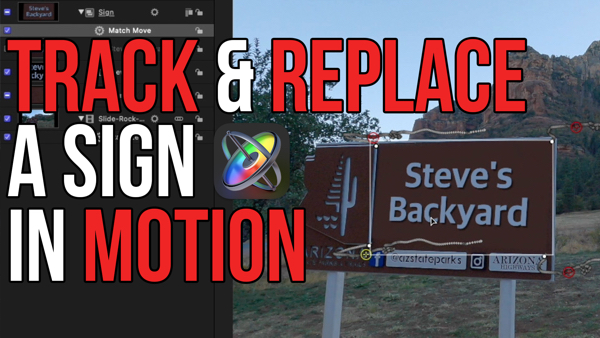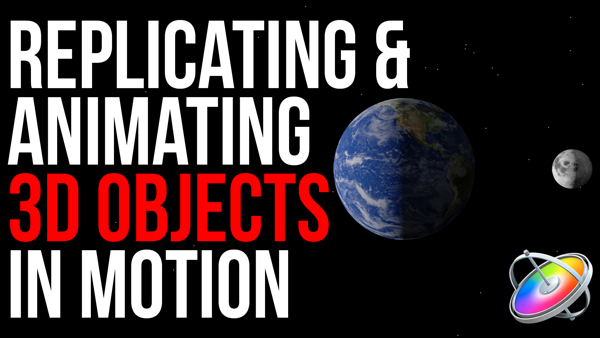How to Create a Custom Transition in Motion 5
In this episode of Motion Magic, Mark Spencer will teach you how to create a custom fall themed transition using Motion’s emitter and a bezier mask.
Learn how to adjust Birth Rate, scale parameters, and Angle, Speed, and Spin Randomness in order to create this effect, and then publish the project as a template to use in Final Cut Pro X.
In this episode, I’ll show you how to make this fall transition effect in Motion and publish it to use in Final Cut Pro X.
I’m Mark Spencer from RippleTraining, welcome to Motion Magic, where you’ll learn visual effects and motion graphics in under 5 minutes.
To start, I’ve launched Motion, and I’ll select a Final Cut Transition Project. I’ll use the 1080 preset at 29.97 frames per second, set the duration to 4 seconds, and click Open.
I’ll press Shift-Z to fit the Canvas to the window. In the Timeline, I’ll extend the Transition A and Transition B placeholders to match the duration of the project. Doing so will allow me to animate a mask to reveal Transition B later.
I want to create a flurry of leaves blowing across the screen. In the File Browser, I’ll navigate to a folder where I have an image of a maple leaf.
I’ll select it and click Import. Then, I’ll click the Emitter button in the Toolbar to create an emitter from the maple leaf.
If I play now, 30 leaves per second start spreading out in all directions. I actually don’t want any new leaves to be created at all, so in the Emitter Inspector, I’ll set the Birth Rate to 0. Instead, I want a fixed number of leaves right from the start, so I’ll set the Initial Number to about 50.
I also don’t want them emitting in all directions, so I’ll press F7 to open the HUD and I’ll limit the emission range, and change the emission angle, so that the leaves spray towards the left and down.
I want the leaves to start off-screen so I’ll press Command-minus a few times to zoom out, then drag the emitter to the top right. Then I’ll choose View, Show Full View Area so I can see the leaves even when they are off the screen.
If I scrub the project now, the leaves start off-screen, but I need to have them move across the screen and leave by the end of the project. So I’ll leave the playhead at the end of the project.
Back in the Emitter Inspector, I’ll increase the Speed until the leaves have cleared the screen. Then I’ll increase Speed Randomness so they move at different speeds, which spreads them out. Then I’ll tweak the speed and also the emission range to get most of them to move across the screen as I scrub the project, with none on at the end.
They still all look the same, though, so with the playhead in the middle of the project, I’ll increase the Angle Randomness, the Spin Randomness, and the Scale Randomness.
To make the leaves have different colors, I first need to remove the current color, so I’ll select the original leaf in the layers list, then use the Filters shortcut menu to choose Color Correction, Hue/Saturation. In the HUD, I’ll decrease Saturation all the way. I’ll return to the Filters menu, to Color Correction, add the Brightness filter, and increase the Brightness value in the HUD.
Now I can reselect the Emitter, return to the Emitter Inspector, and change the Color Mode to Pick from Color Range. Then I’ll open the Gradient Editor, right click the color tags to select new colors,
then click the lower bar to add more color tags and change their colors as well.
If I play that back, I now have maple leaves of different colors, sizes and rotation flying across the screen, moving at different speeds with different spin rates. I’ll make some final tweaks to make sure the leaves start and end off screen and are bunched together enough create a line moving across the screen.
With the playhead in the middle of the project, I’ll now select the Transition A placeholder, then in the Toolbar, select the Bezier Mask tool, and click to create a mask that matches the line of leaves.
Then I’ll turn on recording, move the playhead to the end of the project, and adjust the mask points to move it off screen.
Then I’ll do the same at the start of the project.
And then I’ll scrub the project and adjust the mask as needed.
I’ll turn off recording, and then use the Mask Inspector to feather the mask.
Now I’ll select the Project in the Layers list, and in the Properties Inspector, check the Override FCP Checkbox. Doing so ensures that the transition will be 4 seconds long when initially applied in Final Cut Pro, as long as there are sufficient handles.
I’ll press Shift-V to turn off the full view area, Shift-Z to fit the Canvas to the window, and play the project.
To publish the template, I”ll press Command-S to save, name my template, select or create a category, and click Publish.
If I switch to Final Cut Pro, my new template will be in the Transitions Browser, in the category I created. I can drag it to an edit point, and play.
Click the subscribe button below. If you have an idea, comment or suggestion, leave those below as well. Go to RippleTrainging.com for fast professional training on final cut pro, motion and davinci resolve from industry professionals.
I’m Mark Spencer from RippleTraining, welcome to Motion Magic, where you’ll learn visual effects and motion graphics in under 5 minutes.
To start, I’ve launched Motion, and I’ll select a Final Cut Transition Project. I’ll use the 1080 preset at 29.97 frames per second, set the duration to 4 seconds, and click Open.
I’ll press Shift-Z to fit the Canvas to the window. In the Timeline, I’ll extend the Transition A and Transition B placeholders to match the duration of the project. Doing so will allow me to animate a mask to reveal Transition B later.
I want to create a flurry of leaves blowing across the screen. In the File Browser, I’ll navigate to a folder where I have an image of a maple leaf.
I’ll select it and click Import. Then, I’ll click the Emitter button in the Toolbar to create an emitter from the maple leaf.
If I play now, 30 leaves per second start spreading out in all directions. I actually don’t want any new leaves to be created at all, so in the Emitter Inspector, I’ll set the Birth Rate to 0. Instead, I want a fixed number of leaves right from the start, so I’ll set the Initial Number to about 50.
I also don’t want them emitting in all directions, so I’ll press F7 to open the HUD and I’ll limit the emission range, and change the emission angle, so that the leaves spray towards the left and down.
I want the leaves to start off-screen so I’ll press Command-minus a few times to zoom out, then drag the emitter to the top right. Then I’ll choose View, Show Full View Area so I can see the leaves even when they are off the screen.
If I scrub the project now, the leaves start off-screen, but I need to have them move across the screen and leave by the end of the project. So I’ll leave the playhead at the end of the project.
Back in the Emitter Inspector, I’ll increase the Speed until the leaves have cleared the screen. Then I’ll increase Speed Randomness so they move at different speeds, which spreads them out. Then I’ll tweak the speed and also the emission range to get most of them to move across the screen as I scrub the project, with none on at the end.
They still all look the same, though, so with the playhead in the middle of the project, I’ll increase the Angle Randomness, the Spin Randomness, and the Scale Randomness.
To make the leaves have different colors, I first need to remove the current color, so I’ll select the original leaf in the layers list, then use the Filters shortcut menu to choose Color Correction, Hue/Saturation. In the HUD, I’ll decrease Saturation all the way. I’ll return to the Filters menu, to Color Correction, add the Brightness filter, and increase the Brightness value in the HUD.
Now I can reselect the Emitter, return to the Emitter Inspector, and change the Color Mode to Pick from Color Range. Then I’ll open the Gradient Editor, right click the color tags to select new colors,
then click the lower bar to add more color tags and change their colors as well.
If I play that back, I now have maple leaves of different colors, sizes and rotation flying across the screen, moving at different speeds with different spin rates. I’ll make some final tweaks to make sure the leaves start and end off screen and are bunched together enough create a line moving across the screen.
With the playhead in the middle of the project, I’ll now select the Transition A placeholder, then in the Toolbar, select the Bezier Mask tool, and click to create a mask that matches the line of leaves.
Then I’ll turn on recording, move the playhead to the end of the project, and adjust the mask points to move it off screen.
Then I’ll do the same at the start of the project.
And then I’ll scrub the project and adjust the mask as needed.
I’ll turn off recording, and then use the Mask Inspector to feather the mask.
Now I’ll select the Project in the Layers list, and in the Properties Inspector, check the Override FCP Checkbox. Doing so ensures that the transition will be 4 seconds long when initially applied in Final Cut Pro, as long as there are sufficient handles.
I’ll press Shift-V to turn off the full view area, Shift-Z to fit the Canvas to the window, and play the project.
To publish the template, I”ll press Command-S to save, name my template, select or create a category, and click Publish.
If I switch to Final Cut Pro, my new template will be in the Transitions Browser, in the category I created. I can drag it to an edit point, and play.
Click the subscribe button below. If you have an idea, comment or suggestion, leave those below as well. Go to RippleTrainging.com for fast professional training on final cut pro, motion and davinci resolve from industry professionals.





Have tried several times to make it work. I always end up with a transition graphic flowing across the screen but it does not reveal the second background. I must be missing something telling me to select a different object before setting the second revealing mask from the top right corner.